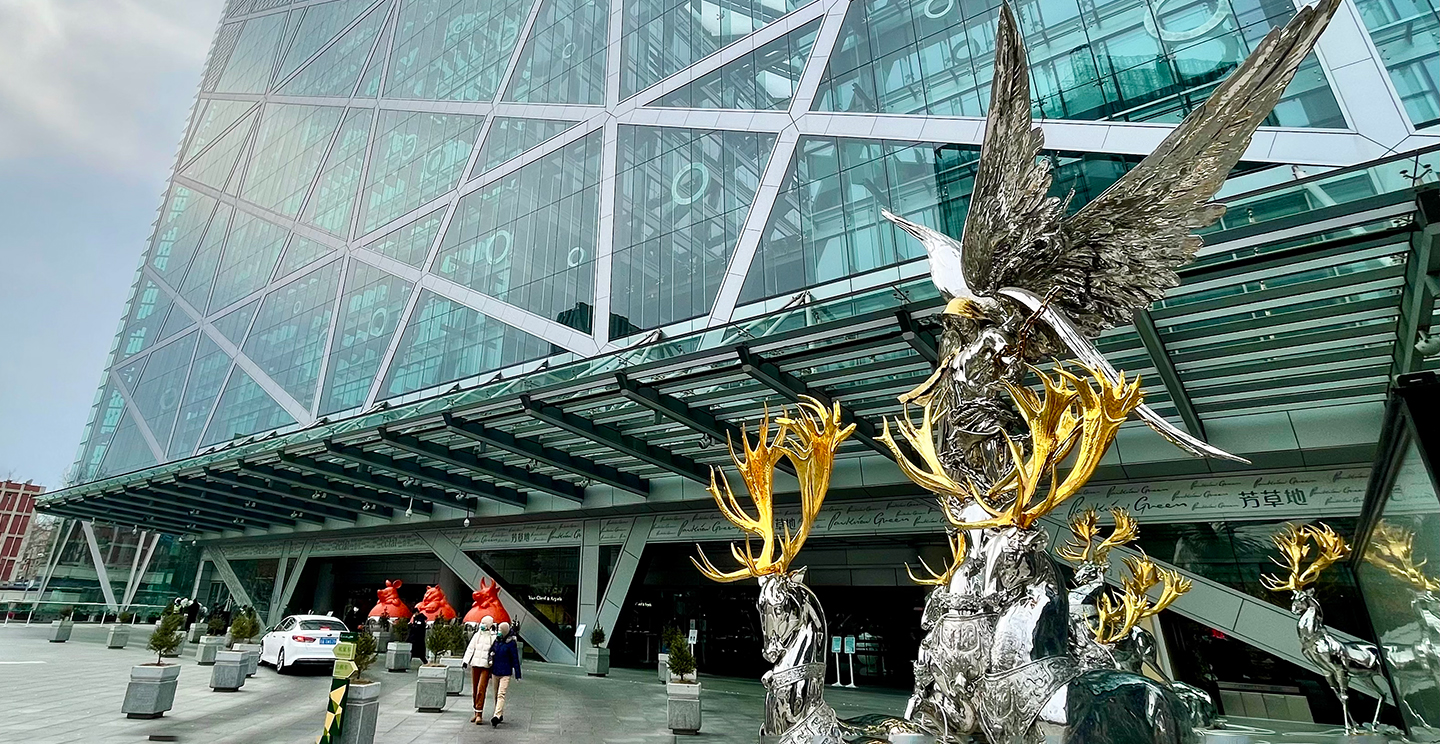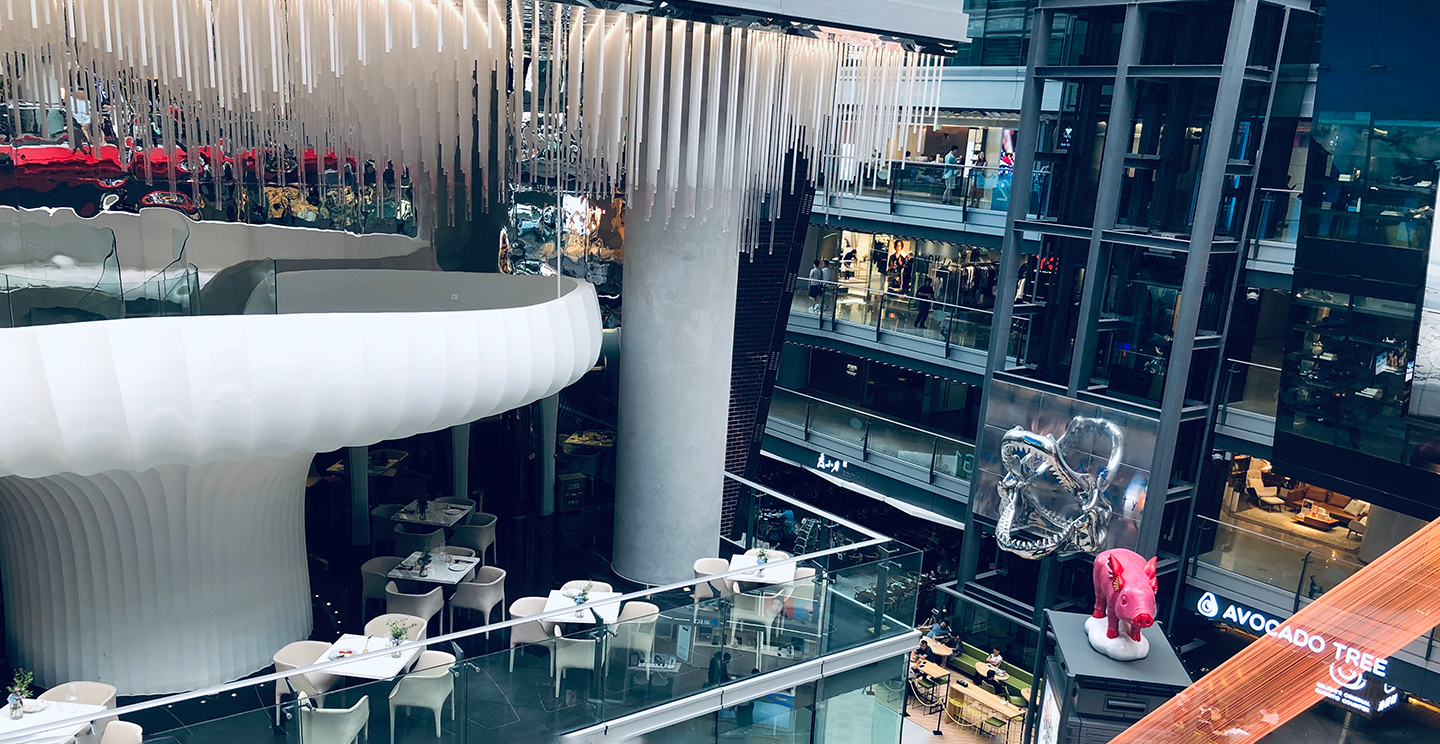Art in the Buyosphere: a stop in Beijing’s Parkview Green
There’s a spaceship from elsewhere, its pointed roof standing out from a distance. It rises from a block of residential buildings in Beijing CBD as if it were an enchanted fortress. Inside, you can find the vast space of two nine-story and two eighteen-story towers. The roof is transparent, and blue light floods the inner area. Under a pyramidal envelope, there are two million square feet of mixed-use space. You are in a shopping mall. You are in a museum. You can find offices, a hotel, even a gym. Some strange magnetism is in the air. Designed by Integrated Design Associates, completed in 2012 and winner of several architecture awards, the Parkview Green is the perfect starting point for this column – The art of Chinese shopping. Here we start our journey through modern spaces.

Beijing’s Parkview Green
The relevance of shopping and wandering around the city in today’s scenario
We are going through a period of great transformations. Technological and social innovations have significantly impacted our whole lives and the buyosphere. Heightened by the recent pandemic, the digital revolution has disrupted retail and the cityscape. New territories, in both real and virtual worlds, herald unprecedented possibilities. In the present scenario, this column aims to reaffirm the importance of shopping and, more generally, wandering around the city as a leisure activity. In my journey through the most emblematic places of our cities, I will focus on the aesthetic experience it can provide to the individual. I will consider fashion and shopping as two inseparable elements. Fashion is a form of creativity, an expression of the self, a business opportunity. Or maybe, from a more nihilist perspective, it is a beautiful illusion, a rainbow veil that stretches over the nothingness of the world. The shopping experience itself is much more than just filling a bag. Like a ritual, it has deeply influenced our lifestyle and the history of modern society.
Four reasons why Parkview Green is the cathedral of modern commerce
It is no coincidence that my journey through the cathedrals of modern retail starts in Beijing. Chinese metropolises can be considered an advanced observation point on the contemporary. The first reason is linked to their fast-changing society and fashion trends. Secondly, because of the strong mutual penetration of real and digital worlds due to the extensive use of information technology. From this perspective, the case of Parkview Green is emblematic. Just by describing this place, I can introduce most of the topics in this column.
1. Experiential retailing. From “I go there just to buy something” to “I’ll buy anything just to go there”
The visitor to this polyfunctional center is not attracted by the mere necessity to buy. Today, you can order online almost every product on sale in this mall and get it delivered to your door. But here, the mood has changed from "I’m going there just to buy something" to "I’ll buy anything just to go there". Customers are looking for an emotional connection with the space through personalized, engaging experiences. The mall matches that kind of expectation, selling an experience rather than just a product, with a prevalence of flagship stores of rare brands that often have their only address in the city here.
2. Serendipity. In trying to get you lost, the mall gives you a one-off adventure
Once glance is not enough to embrace the interior space of the Parkview Green. The plan of the building is asymmetrical. We are forced to stroll around to find our way; we walk up and down the stairs looking for the right way to reach a specific shop or attraction. And finally, we get lost. We might eventually keep on finding other things that draw our attention, until we forget what we were looking for in the first place. The mall provides an adventure.
3. Sustainability. Every detail is imbued with an environmental philosophy
The Parkview Green project meets its goals of energy saving and sustainability. Its structure and materials create an isolated microclimate. The stable internal micro-circulation system is combined with a complex chilled water system. Rainwater is filtered and recycled for irrigation, while the facility uses greywater for flushing.
4. Blurred boundaries. Museum tours and shopping overlap and merge
This mall’s most spectacular and unique quality is that artworks and installations are scattered around retail spaces. Museum tours and shopping overlap and merge, as art and merchandise are separated by an invisible border. Art is somehow downgraded to a product, but the products on sale are promoted to art objects. However, there is still room for improvement in the interaction between architecture and technology. The mall’s app, which is supposed to guide our visit, provides information about artworks and shops, but it still has basic functions and a simple user interface.

Beijing’s Parkview Green
Multi-functional super-places aspire to become the agora and the acropolis of our times
Parkview Green plays with the postmodern condition and status of art, an inspiring element for the fashion industry. Its uniqueness lies in the grandeur of the project and the seamless, coherent experience it can provide. Sheltered under its crystal skin, the customer enjoys an almost religious enchantment. A key feature of luxury fashion products, the symbolic value of merchandise is well perceived. While celebrating the aura of commodities, multi-functional super-places like this one aspire to become, simultaneously, the agora and the acropolis of our times.

